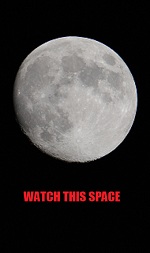Strange. Very strange.
And disconcerting.
Disappointing, too.
Then again it is NASA. A rather bizarre organization, NASA.
You see, this post was initially inspired by my running across an interesting page at Lunar Explorer Italia last night titled AS 15-83-11218 and the Stephenville UFO: a VERY SMART image-comparison (by Carlo Contu). As you no doubt have gathered from said title, Mr. Contu noticed that the Apollo image in question and the sportiest image of the infamous Stephenville, Texas UFO are remarkably similar. You know the one, the pretty rainbow colored squiggly line in the night sky…
So I Googled up the image number, all set to do a session in Photoshop. But it wasn’t available nice and large at NASA History’s Apollo Image Library… in fact they don’t even list the magazine as existing at all! What’s up with that? Note that they do list magazines for which they have no pictures to show yet… so, why not 83?
All was not lost, as they are all shown on the Lunar and Planetary Institute’s Apollo Image Atlas… but the images at LPI are all small, all at low resolution and none are really suitable for delving into in hopes of doing any sort of confident analysis. Some clues came out, though…
Here’s the text at the LPI page for this magazine:
Apollo Image Atlas
70mm Hasselblad Image Catalog
Images AS15-83-11218 to AS15-83-11234
Why does it say “Magazine ??”? Huh? What was that? Note, of course, that right below that line, in the picture range it clearly states AS15-83-xxx to AS15-83-xxx. 83, again, is the magazine number.
Ah, I see, when you go to the individual photos it lists right below them their confusion’s source, they don’t know the Letter sub-designation of magazine 83. Well, why not? And even so does not knowing the letter therefore qualify it’s contents for near oblivion, displayed small and low-res on a sub-site for the Apollo program?
Note: For those not familiar with magazines, they are a removable part of the Hasselblad camera, a film holding ‘magazine,’ pre-loaded with film that eliminates the need to string the film through the camera as in a standard 35mm camera. They just snap on and off the back.
Note, too, that 83 was not the first magazine used by the Apollo 15 crew, so although there seems to be some sort of labeling error, I don’t imagine that there were any other issues with it. The Image Atlas starts at 82… which naturally makes me wonder about the existence of 1 through 81, but that’s not completely relevant here. The ones they do show are otherwise sequential in content.
As you can see below, the images captured are intriguing… to say the least… especially the last one, the swoopy, streaky and oh so freaky AS15-83-11234.
What do they show? I can’t say as I know. I can speculate as well as you can, but unless the impossible happens and the crew of 15 give us a play-by-play description, speculation is all we’ve got. Another thing to speculate about is why are there only 17 pictures? Why did they stop snapping? Must see if I can find anything in the transcripts, but, I rather doubt that if there was anything exciting going on it’d still be within them.
I really do like that last one… what the hell is all that? It’s absolutely fascinating. Was there an encounter with something, something we can barely comprehend, way out there in the cold, vast darkness of space?
Hmmm?



































 What’s All This, Then? is copyright © 2009 to the present by Ignatius F Makarevich - All rights reserved worldwide.
What’s All This, Then? is copyright © 2009 to the present by Ignatius F Makarevich - All rights reserved worldwide.



Excellent job highlighting this! Apollo 15 film magazine #83 is a very anomalous set of shots, with no real firm data on when the 17 shots were supposedly originally exposed. Why is there no firm data? Well, because for three DECADES, this entire magazine was hidden from the public entirely. In fact, if you look in the first official Apollo 15 Photographic Index published in 1972, you will notice that film magazine #83 OFFICIALLY DID NOT EXIST. They skip over it entirely, making NO mention of it at all, going from magazine 82 right to 84. Because mag 83 was never cataloged, it does not have an assigned letter code classifier either. For all practical purposes, this magazine was not publicly acknowledged to even exist until the LPI archive just out of the blue published all 17 frames in their online “Apollo Image Atlas” a few years ago – albeit in 450×450 “large thumbnail” versions only. None of these images is available anywhere in higher resolution online, and when you look at the thumbnails of these frames, you maybe can start to see why perhaps they vanished this magazine for all those years.
Here are a few more things about these images that I noticed – you can see that the film magazines listed immediately before and after (82-SS and 84-MM) were both exposed on the lunar surface. You will also notice that although these 17 photos in Magazine 83 are very low resolution, you can still see that they have Reseau crosshairs on them. This denotes that the frames were shot using one of the lunar surface Hasselblad cameras with the fiduciary spacing plate built directly into the camera body. You can also just barely make out the number “38” on a few of the frames at the bottom center. Now, Dave Scott’s Hasselblad Reseau plate was imprinted with serial #31, and Jim Irwin’s was imprinted with serial #38 – so we know that the pics in magazine #83 were shot through Jim Irwin’s lunar surface Hasselblad. We also know that Jim Irwin’s Hasselblad “broke” whilst he was on the lunar surface during EVA-2 at Dune Crater.
146:32:34 Irwin: Camera’s stopped working.
146:32:36 Scott: It has? Maybe you’re out of film.
146:32:41 Irwin: I just put this on!
Then, the astronauts reported the camera was fixed after they got back to the LM at the end of EVA2. Then, they reported it was busted again during EVA-3, then they say they fixed it after getting back up to lunar orbit. Here is the Apollo 15 Post-Mission Report’s take on Irwin’s camera malfunction.
“Near the end of the second EVA, the LMP’s 70-mm camera ceased to advance film. The crew reported that the camera was again operational after return to the lunar module. The camera was again used on the third EVA; however, after a short series of exposures had been made, the failure recurred. The camera was used for additional photography during the Trans-Earth phase without recurrence of the problem. Post flight analysis of the hardware included operational testing, disassembly and inspection, and measurement of battery charge. Operational testing with film loads indicated proper film advancement until approximately 200 cycles had been accumulated, at which time the failure mode was duplicated several times in succession. The film did not advance, although the motor was running. Disassembly and examination of the drive mechanism showed that the two set screws in the drive pinion were slipping on the motor shaft.”
So, when were these pics actually taken? Well, here are the options as I see them – they are sky shots obviously, possibly long-exposure frames. “Officially”, they could have been taken out on the lunar surface looking skyward at the start of EVA-3, or through the LM overhead rendezvous window between EVA2 and EVA3 (or maybe after EVA3). Or, they could have been exposed in the CSM looking out the window during the return to Earth phase (probably the most likely option in my opinion). Either way, they really are bizarre shots, that is for darn sure. Thanks again for highlighting this very anomalous film magazine!
Cheers,
LunaCognita
Wow, Luna, thanks so much for your wonderful and extensive information and right-at-hand personal knowledge… you rock!
It answers some of my questions, and, naturally raises more! That’s great!
I am quite familiar with Hasselblads, and while their legendary build quality makes it seem highly unlikely, (especially on these Hasselblads), I can nevertheless see such a scenario happening -if- there were perhaps excessive vibrations due to some precarious stowage situation during lift off. But being the world class sort of professionals these guys were, I just don’t know. Anyway…
I’m tending heavily towards your preferred option of them being inside shots from the CSM, no matter their placement in the timeline, as what looks very much like a window frame is clearly visible and there’s a lot of blackness about. Could easily be wrong about that, though, but it seems likely to me too.
After staring at them for a good while now, I’m tending to think that there was an uncomfortably close presence passing by or orbiting around them, and the streaks we see are the visual remnants of whatever electromagnetic forces (or some otherwise undetermined) were generated by that very bright “light.” Or… object… :)
God, Luna, just image they’re on the surface, right… and they see this big glowing thing approaching… I mean really approaching… they go into survival mode and haul ass back into the LM… and watch… and… WOW! Wow no matter where they were or when.
Don’t know when you caught it, but I put the slideshow up top for a better presentation… for those unfamiliar they go in sequence… the Stephenville looking squiggle is shot number 1, and the very streaky one with the “rings” is the last. One gets the impression that that large object passes very, very closely.
Thanks again LunaCognita!
Be well, Sir,
Iggy
Hey, no problem Iggy. Thank YOU for posting that story up! It really does highlight the fact that NASA has buried and suppressed imagery from the Apollo program to deliberately hide it from us, even going to the extremes of altering their public Photographic Index catalogs to remove any reference to the imagery from the public record. For 30 years, there was nothing in the official archives to suggest that Apollo 15 Magazine #83 ever even existed. That SHOULD scare and upset everybody who thought that NASA’s claims of transparency and openness with all their image evidence from Apollo was the truth. Clearly, that is not the case at all.
Plus, let’s keep in mind that Magazine #83 from Apollo 15 is a black&white film magazine, and that means it held 200 exposures of 70mm film. So, how the heck are we supposed to know that ONLY 17 frames were actually exposed in total? I mean, it is not like NASA was honest with us about this film magazine to begin with, and now we again have NO option but to trust NASA when they say that Mag#83 only had 17 exposures on it. I think it would be more accurate to say that Mag#83 had 17 exposures that NASA was willing to eventually (three decades after the fact) declare and publish. It would not shock me in the slightest if we were to learn that NASA are just showing us the worst 17 frames from the 200 that actually were exposed on Mag#83.
I really do not buy NASA’s camera failure argument either. Could it be true? Sure it could. However, faking a camera failure is also EXACTLY what you would do if you wanted to decrease the amount of available image evidence the public had access to analyze and use for comparative analysis against other declared archive imagery. It is an insanely simple and effective cover up technique to exploit, because the public thinks the camera broke so NASA didn’t have to show us any of the imagery taken by that camera after the “break” claim is made, and sadly there is absolutely NO way for the public to verify that it really did “break”. I think it becomes a question of credibility, and NASA (and their support base) have always liked to claim that the space agency have never lied or hid any evidence from the public, stating that they have always had every frame of film shot during the Apollo Program in their public archives where anyone can see them. Of course, magazine#83 from Apollo 15, when combined with the fact that NASA’s official published Photographic Index from 1972 for that mission deliberately and nefariously omits ANY reference to it at all, demonstrates that claim of full transparency and openness is a lie.
That comparison with that first frame and the “Stephenville lights” image you highlighted is a good one! That is an interesting parallel to consider, that is for sure! Awhile back, I tried to purchase all 17 of those Mag#83 frames from NASA so I could get them in high res, but I got some run-around from the official image providers. Here is the first reply I got from Pound Labs, who I believe are STILL referenced on some NASA sites as being one of the official image providers.
“I am sorry, but we are no longer doing any scanning/printing of NASA images. You will need to contact Mary J. Russell(Jody) at JSC and she can give you information on what labs are available for the services needed. Here is her email address: mary.j.russell-1@nasa.gov.
Sincerely,
Lori Mitchell
Pounds Photographic Labs”
Then I tried another of the official photo providers listed by NASA – “Bay Area Imaging”. Emily Folk, from Bay Area imaging told me this –
“To obtain the negatives or digital files for the images requested, you will need to contact Jody Russell with the Media Resource Center at NASA. Her email is: Mary.J.Russell-1@nasa.gov . Pricing varies depending on what media we are working from and what size prints you would like made.”
So, I sent Ms. Russell not one but two emails requesting NASA provide the 17 negatives from Mag#83 to Bay Area Imaging so I could purchase high res scans of them, and never got a word of reply to either email. That was well over a year ago, and I forgot all about it till I saw your blog post about Mag#83. Perhaps it is time for another attempt, because otherwise we will probably have to wait till hell freezes over to get any HR scans of those frames!
Just as another example of NASA “accidentally” forgetting to provide the public with certain frames of film, we can go to the NASA/LPI online image archive (called the “Apollo Image Atlas”), which they claim shows us every frame of film shot through the Hasselblad camera system during the Apollo Program. This LPI archive even shows us the “blank” frames that do not have any image data on them at all, certainly providing the appearance of full transparency with the evidence. Take a look at this page here however, showing the Apollo 17 70mm catalog index – http://www.lpi.usra.edu/resources/apollo/catalog/70mm/mission/?17 What happened to frame #20680 or #20681? What, did those frames never exist either? Hmm…perhaps the fact that #20680 shows a massive pyramid structure on the lunar surface might have something to do with NASA’s denial of that frame’s existence in the LPI online archive, and it might have something to do with why NASA has deliberately mis-cataloged that particular frame since 1973 in their other image archive indexes (print and online) as well.
NASA definitely knows how to bury evidence, that is for sure! They have been doing it since day one, and have hidden behind the perception of credibility they have built up that makes many in the public trust anything and everything they tell us without challenge. It seems like for decades, all NASA had to do was claim they are telling us and showing us the full truth, and many people just swallowed that claim hook, line and sinker without wanting to question the fact that all the “evidence” being provided for us about the Apollo Program to examine and rely on comes from a singular source – NASA! They have a monopoly on the Apollo evidence, and it is a LOT easier for them to cover something up if they are the only ones providing all the evidence, right? Thankfully however, even though NASA still claim they have been fully transparent, there are examples to show they have been less than truthful and less than complete with their disclosure – Magazine #83 from Apollo 15 is PROOF of that!
Cheers my friend, and keep the evidence coming!
LunaCognita
[…] what’s known of this exceptionally bizarre incident by reading my earlier post about this strange encounter, which has some great commentary from LunaCognita providing even more vital […]